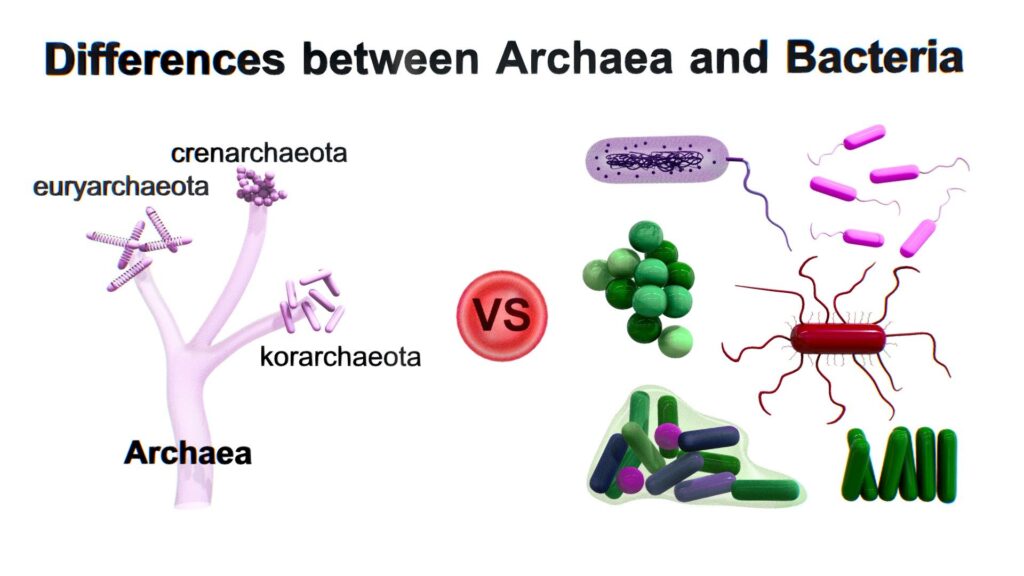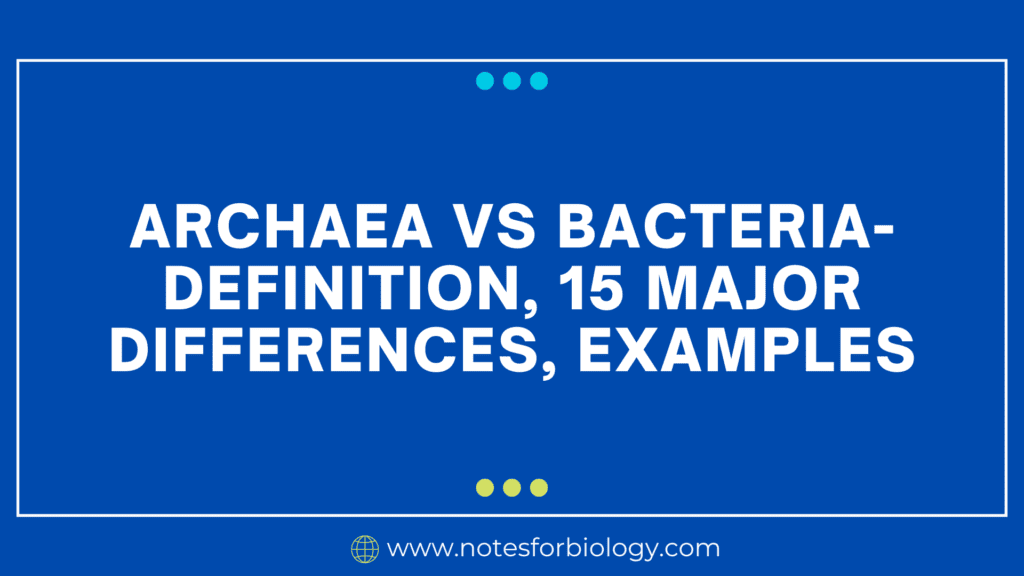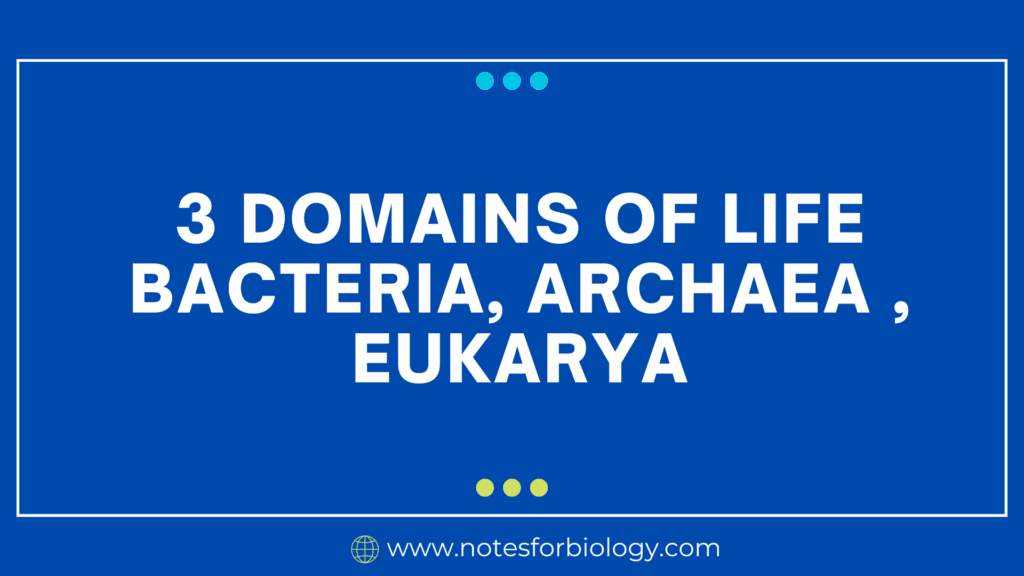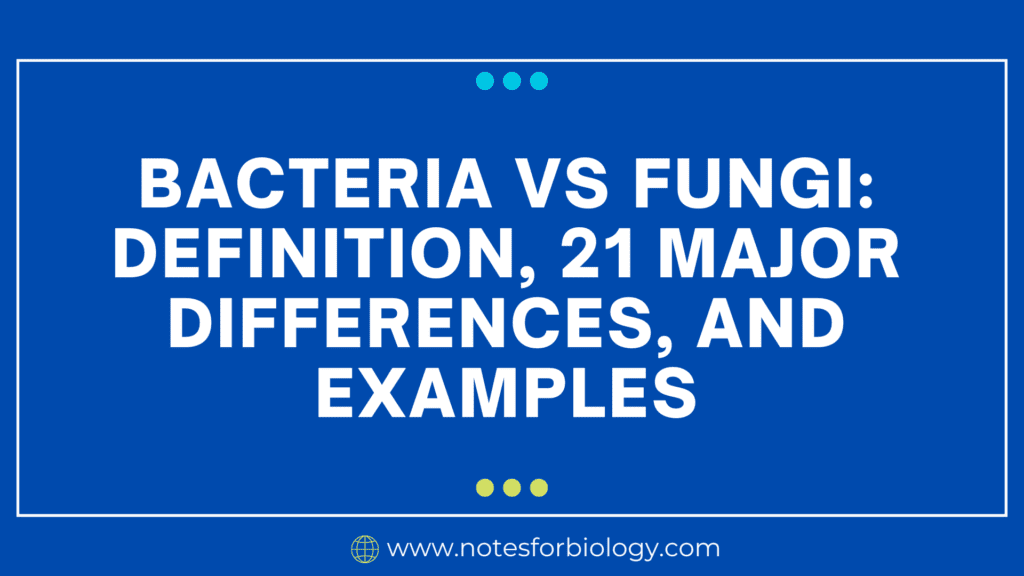Despite their outward similarities, the prokaryotic microbes known as Archaea and Bacteria have different genetic, biochemical, and physiological traits. Below is a summary of their definitions, along with some key distinctions and instances.
Table of Contents
Definition of Archaea
Archaea: The single-celled microorganisms known as archaea are related to bacteria but differ in their molecular and biochemical makeup. They frequently inhabit harsh settings including salt lakes, deep-sea hydrothermal vents, and hot springs.They have a wide range of energy sources that they use, and their metabolism exhibits a variety of chemical interactions. They are divided into nutritional groups according to carbon sources and energy based on their reactions. One kind of archaea gets its energy from the sun. We call them phototrophs. However, oxygenic photosynthesis is absent from all of these species.
The other types of archaea get their energy from inorganic substances like sulfur or ammonia. We refer to them as chemotrophs. They either contain methanogens, nitrifiers, and anaerobic methane oxidizers. Two chemicals are involved in this reaction; one serves as an electron donor and the other as an acceptor of electrons. Adenosine triphosphate, or ATP, is released during the process as a result of the energy released.
Definition of Bacteria
Bacteria: are a diverse group of unicellular microbes that can be found in almost all environments on Earth. They can live in a variety of settings, such as soil, water, and the human body. They can come in a vast variety of forms and metabolic kinds.
They even have a cellular structure that performs a variety of cyclic tasks, such as protein transportation and energy transmission. Plasmids, which are circular segments of extra-chromosomal DNA, make up bacteria.An outer cell wall and an interior cell membrane make up bacterial cells. wherein certain bacteria, like mycoplasmas, lack a cell wall. Bacteria can have a third layer of protection on their outermost cell, known as a capsule.
Major Differences Between Archaea and Bacteria
| SN | Archaea | Bacteria |
| 1. | The early prokaryotes known as archaea belong to a different domain from bacteria and eukaryotes because of their unique features. | The domain of primitive, single-celled organisms known as bacteria is diverse in terms of size, shape, structure, and even environment. |
| 2. | Divided into different groups like Methanogens, Thermophiles, and Halophile | Divided as Gram-positive and Gram-negative |
| 3. | Cell wall is Pseudopeptidoglycan. | Cell wall is Lipopolysaccharide/ Peptidoglycan |
| 4. | They perform modified form of glycolysis and citric acid cycle. | They perform glycolysis and citric acid cycle. |
| 5. | Ether-linked lipids. | Ester-linked lipids. |
| 6. | They can sustain in extremely harsh environments such as hot springs, marshlands, deep sea vents, and the gut of humans and ruminants. | They are found everywhere, including soil, organic matter, the earth’s crust, water, bodies of animals and plants, radioactive wastes, hot springs etc. |
| 7. | Archaea reproduce by fission, budding, and fragmentation. Sporulation doesn’t occur in archaea. | Some bacteria are capable of forming spores that help them survive extreme conditions for a particular period of time. |
| 8. | tmRNA (transfer messenger RNA) is found in archaea. | tmRNA is found in bacteria. |
| 9. | The fatty acids in membrane lipids of archaea are bound to glycerol by ether bonds. | The fatty acids in membrane lipids of bacteria are bound to glycerol by ester bonds. |
| 10. | Instead of producing oxygen through photosynthesis, archaea are phototrophs, meaning they get their energy from the sun. | Numerous bacteria with pigments for photosynthesis are able to produce their own sustenance through photosynthesis. |
| 11. | Have unique metabolic pathways, such as methanogenesis. | Do not perform methanogenesis and have more diverse metabolic pathways |
| 12. | Often found in extreme environments (extremophiles), though they can also be found in moderate environments. | Found in a wide range of environments, from extreme to moderate conditions. |
| 13. | Horizontal gene transfer occurs but is less common and less well-understood. | Horizontal gene transfer is common through transformation, transduction, and conjugation. |
| 14. | Have phospholipids with ether bonds and branched chains. | Have phospholipids with ester bonds and straight chains. |
| 15. | Exhibit a wide variety of shapes, including unusual forms like square or flat cells. | Have more traditional shapes like rods (bacilli), spheres (cocci), and spirals (spirilla). |

Frequently Asked Questions(FAQ)
What are the major differences between Archaea and Bacteria?
The construction of bacterial and archaeal flagella differs; While certain bacteria create spores, archaea reproduce via fission; The molecular composition of bacterial and archaeal DNA and RNA differs significantly; No archaea are harmful, however certain bacteria are (they cause disease).
What characteristics distinguish Archaea and Bacteria?
The composition of cell walls, the lipid architectures of membranes, and metabolic capacities are different between Archaea and Bacteria. While Archaea are capable of distinct metabolisms like methanogenesis, bacteria display a great deal of metabolic variety through processes like fermentation and photosynthesis.
What is the function of the archaea?
Under the harsh environmental conditions of the bog ecosystem, Archaea contribute to the functioning of the ecosystem and vegetation by performing functions involved in nutrient cycling, stress response, and phytohormone biosynthesis and by interacting with both bacteria and their hosts.
Is Archaea autotroph or heterotroph?
Most Archaea and Bacteria are autotrophs. Plants are photoautotrophic. They use light from the sun to make the food they need to survive. People are heterotrophs.
Related Article



